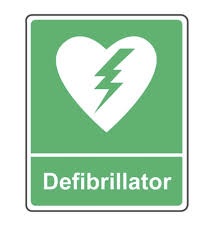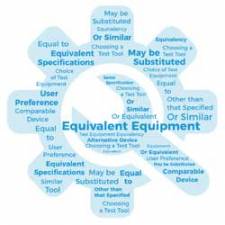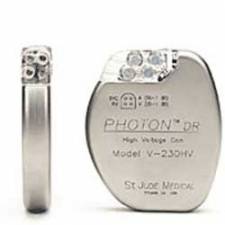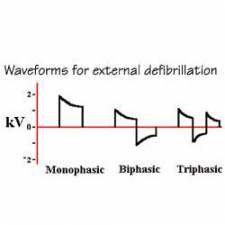An AED is a small, compact device that interprets heart rhythms and can deliver electrical shocks to treat sudden cardiac arrest. The main difference between AEDs and the manually operated defibrillators often used by medical professionals is that AEDs are designed for use by people who may not have the extensive training required to use a manual defibrillator.
SUDDEN CARDIAC ARREST
Sudden cardiac arrest (SCA) occurs because the normal electrical rhythm that controls the heart is replaced by a chaotic disorganised electrical rhythm called ventricular fibrillation (VF). When a heart goes into an uncoordinated electrical activity called fibrillation, the heart twitches ineffectively, can't pump blood and appears to have stopped beating. This condition is called sudden cardiac arrest (SCA) and often accompanies severe heart attacks.
Sudden Cardiac Arrest (SCA) is one of the most common causes of death in developed countries. It is estimated that more than 3 million people worldwide die from SCA each year.
SCA is an electrical malfunction of the heart typically associated with an abnormal heart rhythm known as ventricular fibrillation. It is a condition in which the heart's electrical impulses suddenly become chaotic, causing an abrupt cessation of the heart's pumping action. Victims collapse and quickly lose consciousness, often without warning. Unless a normal heart rhythm is restored, death follows within a matter of minutes. The average survival rate is less than five percent.
HOW DO YOU TREAT SUDDEN CARDIAC ARREST?
A heart in ventricular fibrillation must be defibrillated. An AED delivers a high energy electric shock to a victim in SCA caused by VF to restore the heart’s normal rhythm. AEDs are compact, portable, easy to use and guide the operator through the process with prompts and commands. The AED analyses precisely the victim’s heart rhythm and will only deliver a shock if it is required. To defibrillate the heart -to stop the chaotic and unproductive quivering of VF - an electrical shock must be applied. Defibrillation is recognized as the definitive treatment for ventricular fibrillation. Defibrillation administered within the first few minutes after collapse has the highest chance of success. The likelihood of successful resuscitation decreases by approximately 7-10 percent with every minute that passes. After several minutes, very few resuscitation attempts are successful. Thus, the most important element in the treatment of SCA is providing rapid defibrillation therapy.

The "Chain of Survival" is recommended for responding to sudden cardiac arrest. Early defibrillation is widely regarded as the single, most important step in the Chain of Survival.
AEDs are very simple to operate. You don't need to recognize or interpret heart rhythms, because the AED does that automatically. Modern AEDs are very reliable and will not allow a shock to be given unless it is needed. They are extremely unlikely to do any harm to a person who has collapsed in suspected SCA. They are safe to use and present minimal risk to the rescuer. These features make them suitable for use by members of the public with modest (or even no training), and for use in Public Access Defibrillation schemes. The Automated External Defibrillator (AED) is a small, portable device that administers an electric shock to the heart. A built-in computer assesses the victim's heart rhythm, judges whether defibrillation is needed, and then administers an appropriate level of shock. Audible and visual prompts guide the user through the process. An AED unit will stun the heart, disrupting the electrical chaos, and allow the normal electrical sequencing of the heart and pumping action to resume.
The AED is designed to be used by a layperson "first responder" - a person with AED training. No medical training is needed to use an AED. The use of an AED is not recommended in children less than 1 year old but is quite appropriate in older children and teenagers. Standard adult defibrillator pads are suitable for use in children older than 8 years old. In younger children (between 1 and 8 years), special paediatric defibrillator pads should ideally be used.
Here is a summary of how an AED unit works:
The first prompts tells the user to connect the electrodes to the AED and to stick the adhesive electrode pad(s) to the victim's bare chest. The electrodes send the heart's electrical rhythm data (ECG) to the AED unit.
The AED then analyzes (and sometimes displays) the ECG heart rhythm. It checks characteristics such as frequency, shape, slope, amplitude and heart rate. Based on these characteristics, the AED determines whether or not a shock is needed.
If a shock is needed, the AED will prompt the user to either press a button to deliver the shock, or to stand back to deliver the shock automatically. The AED starts building up the required electrical charge and then delivers an electrical shock to the victim.
The AED next re-analyses the heart rhythm to determine if another shock is needed. If so, another shock is administered.
If a "shockable" heart rhythm is not detected, the AED will prompt the user to check the victim for a pulse and to perform CPR.
In all cases, CPR should be administered - using an AED for resuscitation is not enough.
The Resuscitation Council (UK) recommends that those who train others in the use of AEDs should be appropriately qualified. Provided that they are skilled in teaching and able to demonstrate core competencies in Basic Life Support and the use of an AED the following persons are suggested: doctors, nurses, resuscitation officers, community defibrillation officers, statutory ambulance service instructors, voluntary aid societies (VAS) and rescue organisations, and other individuals such as accredited first aid trainers. This list is not exhaustive.
For someone with no prior experience or knowledge it is likely that approximately 4 hours training will be required to cover the core competencies, assuming an optimum ratio of instructors to trainees and manikins to trainees (see below). Because it is often necessary to include additional training to cover the requirements of particular groups of trainees additional time may be needed.
Skills in basic life support and the use of an AED are rapidly lost after training. It is important that these skills are refreshed regularly, particularly by those who have a duty to respond in an emergency. The principle should be that skills are maintained at an effective level at all times. Individual employers and organisations should make arrangements for retraining to be available. The frequency of this refresher training will depend on the individual but, for guidance, skills should be refreshed at least once a year, but preferably more often. There is no specific legal requirement for employers to provide defibrillators in the workplace. The Health and Safety Executive's syllabus of first aid training for offshore installations does include the use of defibrillators but this is not extended to onshore first aid. However, the Health and Safety (First-Aid) Regulations 1981 do not prevent an employer from providing defibrillators that could benefit both their employees and the public.
 The RC (UK) has designed a sign which many public spaces equipped with a Public Access Defibrillator (PAD) will display. If you witness someone who has collapsed possibly because of cardiac arrest, dial 999 to call the emergency medical services immediately.
The RC (UK) has designed a sign which many public spaces equipped with a Public Access Defibrillator (PAD) will display. If you witness someone who has collapsed possibly because of cardiac arrest, dial 999 to call the emergency medical services immediately.
Follow the instructions given by the ambulance control centre who will provide instructions about the steps to be taken. This may include the location of the nearest PAD. Staff working at the location should also know the location of an AED nearby.
Sources:
http://www.aed101.com/functions-aed.htm
http://www.homeheart.co.uk
http://www.resus.org.uk





